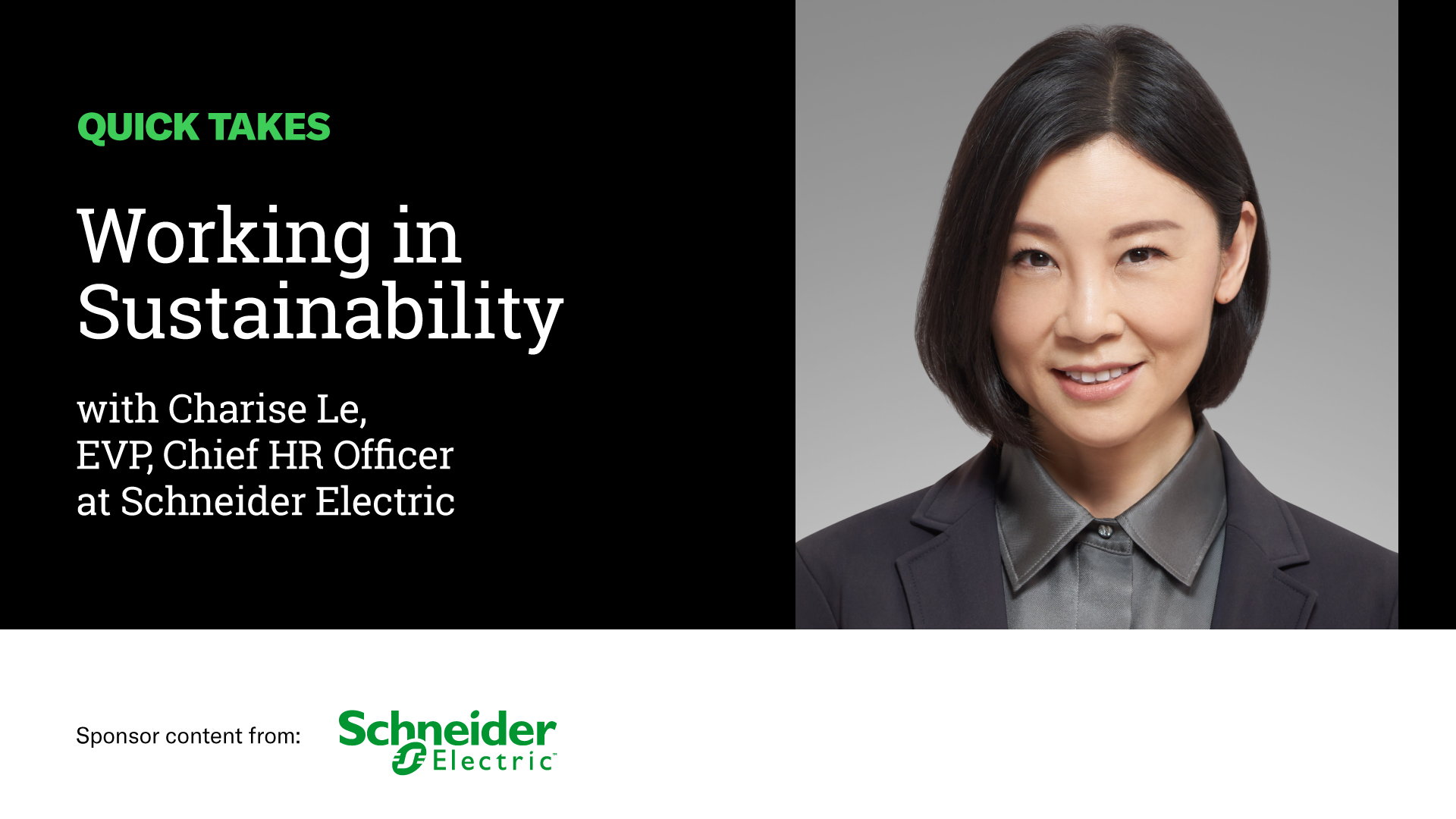Physical Address
304 North Cardinal St.
Dorchester Center, MA 02124
Physical Address
304 North Cardinal St.
Dorchester Center, MA 02124

Todd Pruzan, HBR
Welcome to the HBR Video Quick Take. I’m Todd Pruzan, senior research and special projects editor at Harvard Business Review. As the world sets its ambitious sustainability goals, companies are focusing on redefining and sometimes reinventing their business operations. The acceleration of these efforts is also shaping the landscape of work. We’re here today with Charise Le, Executive Vice President and Chief Human Resources Officer at Schneider Electric, to discuss how business leaders and their organizations are adapting, thriving and driving sustainable progress in this transformative era. Charise, thanks for being with us.
Charise Le, Schneider Electric
Thank you for inviting me, Todd.
Todd Pruzan, HBR
Charise, how are growing decarbonisation efforts changing the world of work?
Charise Le, Schneider Electric
That. I think the demand for climate-related jobs will only increase as organizations around the world look to accelerate their decarbonization efforts. Our study with Boston University found that the application of clean energy technologies in new and retrofitted buildings could create more than two million jobs.
On the other hand, the preferences of workers are changing, and people are increasingly oriented towards sustainability. And Deloitte found that nearly 50% of self-reported higher earners have considered changing jobs to work for a more sustainable company – so big opportunities for organizations to reshape their people practices to build engagement.
Todd Pruzan, HBR
Sounds like a great opportunity. Charise, according to some recent studies the growth in demand for green skills is outstripping supply. How can businesses help close the skills gap?
Charise Le, Schneider Electric
I think that companies have roles that they play in two dimensions – one, to help their people; and secondly, to help society.
As for your own people, I think the first thing you need to do is take your own commitment to sustainability. Raise awareness among your people about the value of green skills. This is how you create a sense of urgency and a desire to learn. Another thing companies need to do is invest in training, and do it quickly and at scale – for example, buying courses instead of creating them in-house, for cutting-edge knowledge and partnerships with educational institutions. And third, companies must foster a culture of continuous learning, by creating programs to facilitate the transfer of skills among colleagues and by recognizing and empowering experts, and most importantly, by allocating dedicated time for people to learn.
And the second dimension, which I mentioned earlier, is to go beyond one’s own employees – that is, to help society. For example, one of our sustainability ambitions is to train one million people in energy management by 2025. And so far we have reached more than 608,000 people.
Another example is our partnership with InnoEnergy. This university is a co-founding partner with the European Union and we have sponsored their master’s programs focused on skills for sustainable energy engineering and innovative strategies to create smarter, more sustainable and resource efficient communities. I think companies can play a key role. It is important to have a vision and to be intentional in acting.
Todd Pruzan, HBR
Sounds like a very, very ambitious job. Charise, what can companies large and small do to attract and retain today’s more sustainability-driven talent?
Charise Le, Schneider Electric
I think first of all we have to think about what people want. People need to feel that they share the same vision and values and that they are part of the company’s sustainability efforts. And the talent that’s more focused on sustainability—they’re not buying what you’re doing; they buy why you do it. So, to begin with, you need to hire people who believe what you believe.
Our employee value proposition at Schneider, Impact Starts With Us, reflects a company where we invite all our employees and people in our ecosystems – partners, customers and suppliers – to contribute to turning sustainability ambitions into action. Now, declaring your vision is not good enough. Organizations need to have the conversation. You have to approach recruitment in a targeted manner.
Schneider Go Green is an example. It is an annual global competition for university students to share their ideas for a cleaner, more inclusive and sustainable world. It was first launched in 2011, and last year we had more than 19,000 registered students from over 70 countries.
And you have to set goals. Goals ranging from decarbonization to DEI cannot and cannot be isolated or met by a single team. They must be incorporated into all aspects of the company’s operations and be seen as a common goal. Then, those goals need to be communicated in a way that helps people understand how they can contribute to success. And progress should also be shared transparently and regularly to encourage accountability.
Companies should make it easy for employees to reduce their own carbon footprint in the office or at home, and in this way you infuse sustainability into the company culture. I mentioned training earlier. This definitely proves the company’s investment in employee growth and alignment with their values.
In the end, apart from the professionals that we are, we are all human beings. And we work better and are more engaged when we feel safe, making a difference and being recognized for our impact.
Todd Pruzan, HBR
OK, great guidelines for organizations and anyone. Charise, thank you so much for sharing your insights on sustainability policies through an HR lens today.
Charise Le, Schneider Electric
Thank you so much for having me, Todd.
Todd Pruzan, HBR
We spoke to Charise Le, Executive Vice President and Chief Human Resources Officer at Schneider Electric, about sustainability.
You can explore more insights into Schneider Electric and its sustainable approach at se.com.